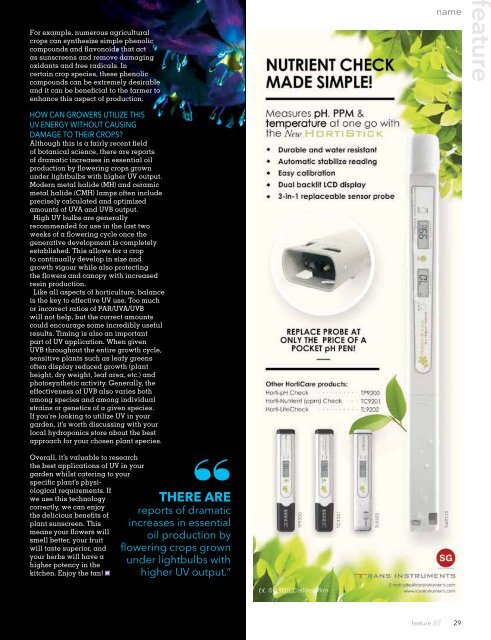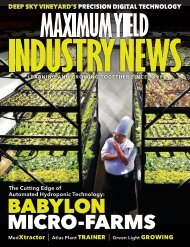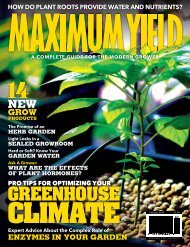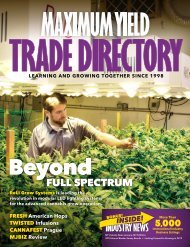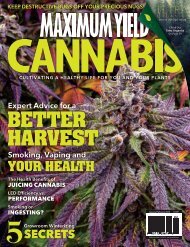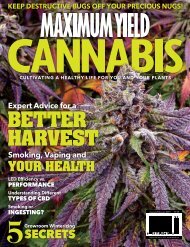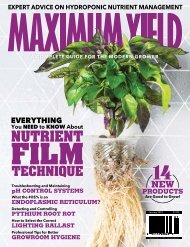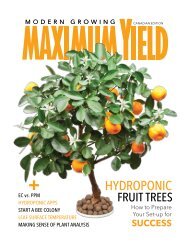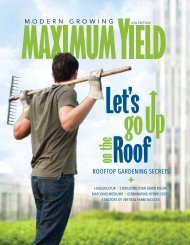Maximum Yield Modern Growing | Canadian Edition | May June 2017
In this issue of Maximum Yield, we cast a wide net to bring you the best and latest information possible to help you get started growing your own food. From the basics like cleaning your equipment to the best methods for preparing your plants to live outdoors, to more advanced topics like lighting and nutrient delivery, there is something in this issue for all levels of grower.
In this issue of Maximum Yield, we cast a wide net to bring you the best and latest information possible to help you get started growing your own food. From the basics like cleaning your equipment to the best methods for preparing your plants to live outdoors, to more advanced topics like lighting and nutrient delivery, there is something in this issue for all levels of grower.
You also want an ePaper? Increase the reach of your titles
YUMPU automatically turns print PDFs into web optimized ePapers that Google loves.
For example, numerous agricultural<br />
crops can synthesize simple phenolic<br />
compounds and flavonoids that act<br />
as sunscreens and remove damaging<br />
oxidants and free radicals. In<br />
certain crop species, these phenolic<br />
compounds can be extremely desirable<br />
and it can be beneficial to the farmer to<br />
enhance this aspect of production.<br />
name<br />
eature<br />
HOW CAN GROWERS UTILIZE THIS<br />
UV ENERGY WITHOUT CAUSING<br />
DAMAGE TO THEIR CROPS?<br />
Although this is a fairly recent field<br />
of botanical science, there are reports<br />
of dramatic increases in essential oil<br />
production by flowering crops grown<br />
under lightbulbs with higher UV output.<br />
<strong>Modern</strong> metal halide (MH) and ceramic<br />
metal halide (CMH) lamps often include<br />
precisely calculated and optimized<br />
amounts of UVA and UVB output.<br />
High UV bulbs are generally<br />
recommended for use in the last two<br />
weeks of a flowering cycle once the<br />
generative development is completely<br />
established. This allows for a crop<br />
to continually develop in size and<br />
growth vigour while also protecting<br />
the flowers and canopy with increased<br />
resin production.<br />
Like all aspects of horticulture, balance<br />
is the key to effective UV use. Too much<br />
or incorrect ratios of PAR/UVA/UVB<br />
will not help, but the correct amounts<br />
could encourage some incredibly useful<br />
results. Timing is also an important<br />
part of UV application. When given<br />
UVB throughout the entire growth cycle,<br />
sensitive plants such as leafy greens<br />
often display reduced growth (plant<br />
height, dry weight, leaf area, etc.) and<br />
photosynthetic activity. Generally, the<br />
effectiveness of UVB also varies both<br />
among species and among individual<br />
strains or genetics of a given species.<br />
If you’re looking to utilize UV in your<br />
garden, it’s worth discussing with your<br />
local hydroponics store about the best<br />
approach for your chosen plant species.<br />
Overall, it’s valuable to research<br />
the best applications of UV in your<br />
garden whilst catering to your<br />
specific plant’s physiological<br />
requirements. If<br />
we use this technology<br />
correctly, we can enjoy<br />
the delicious benefits of<br />
plant sunscreen. This<br />
means your flowers will<br />
smell better, your fruit<br />
will taste superior, and<br />
your herbs will have a<br />
higher potency in the<br />
kitchen. Enjoy the tan!<br />
“<br />
THERE ARE<br />
reports of dramatic<br />
increases in essential<br />
oil production by<br />
flowering crops grown<br />
under lightbulbs with<br />
higher UV output.”<br />
feature<br />
29


